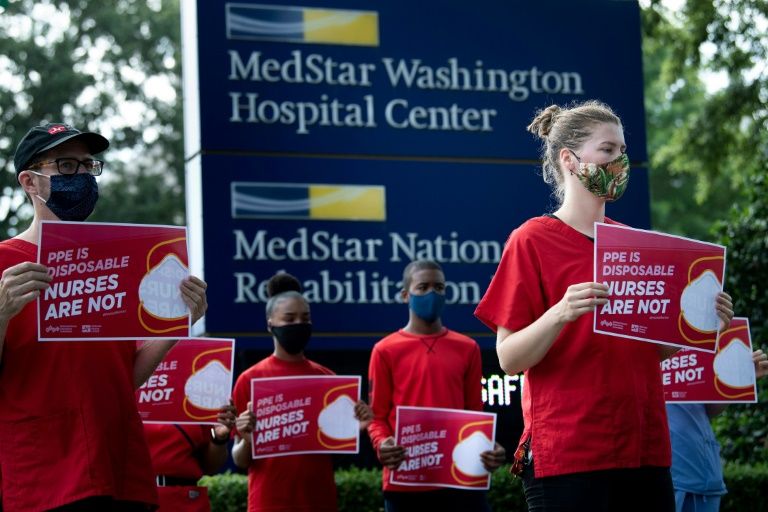US coronavirus cases ease in some hotspots
But signs of hope are emerging in some regions.
The southwestern state of Arizona, which broke 5,000 daily cases in late June, has seen its infections consistently falling throughout this month and the level is now around 2,000.
“Part of that downward trend is as a result, not of universal masking, but certainly a lot more people are masking than were, say, a month ago,” Matthew Heinz, a hospital doctor in Tucson, told AFP.
Elsewhere in the south, Florida’s new cases have been flatlining for the past week, according to a seven-day-average, while the growth rate in Texas is beginning to ease.
Fatality rates remain high in all three states because of the inevitable lag time between progression of the disease and death.
Florida, for example, announced 173 deaths Thursday, a new daily record.
– California surge –
The better results in some parts of the country are being offset by worse outcomes in others.
The virus continues to surge in California, the country’s most populous state, which on Wednesday reported its highest number of infections with nearly 13,000 cases.
Some other states, such as Missouri in the Midwest, are likewise continuing to see their daily case records broken.
Still, the national graph appears to be starting to stabilize at around 70,000 cases per day, according to a seven-day-average from the COVID Tracking Project.
The US saw an earlier plateau after its first peak in mid-April until the surge that began in mid-June.
“I think the leveling off suggests that some of the more recent efforts to ramp up testing and especially in masking and banning indoor gatherings such as bars and restaurants may be helping,” said Thomas Tsai, a public health professor at Harvard.
“However, just like it was in April, leveling off is not enough — the goal is to suppress and not just mitigate.”
Unless the high caseload is brought down, it will continue to place an excessive strain on hospitals, make it harder for schools to reopen in the autumn, and cause more preventable deaths.
Over 80 percent of all Intensive Care Unit beds are occupied in nine states, according to data from the Department of Health and Human Services. This is considered dangerously high.
What’s more, if any region has high cases, the movement of people means it can quickly spark a surge elsewhere.
“The pattern of COVID hotspots speaks to the importance of staying vigilant,” underscored Tsai.
“Masking, social distancing, and a TTSI (trace/test/supported isolation) approach can work, but it works best as an action and not as a reaction.”
– ‘Too early to tell’ –
Other experts are more cautious about whether the current slowdown really reflects reality.
“It’s likely due in part to testing bottlenecks,” said Nicholas Reich, an biostatistician at the University of Massachusetts, Amherst.
Some of the models suggest a few more weeks of slight growth and then a decline, while others show a steady decline from here on out.
But models are only as good as the data fed into them and projections will be skewed if the data is imperfect — perhaps because of delays in getting test results back in hotspots.
“I think it’s much too early to tell,” said William Schaffner, a health policy professor at Vanderbilt University.
He added the US continues to suffer from the lack of a national strategy, with states left to decide too much for themselves.
If, in two weeks time, hotspots like Arizona are continuing their downward trend, “then I have comfort,” he said.
“But these are very, very fragile circumstances.
“There are a lot of people who are ignoring, still, the social distancing recommendations and the masks. I’m still pretty pessimistic.”
Disclaimer: Validity of the above story is for 7 Days from original date of publishing. Source: AFP.


